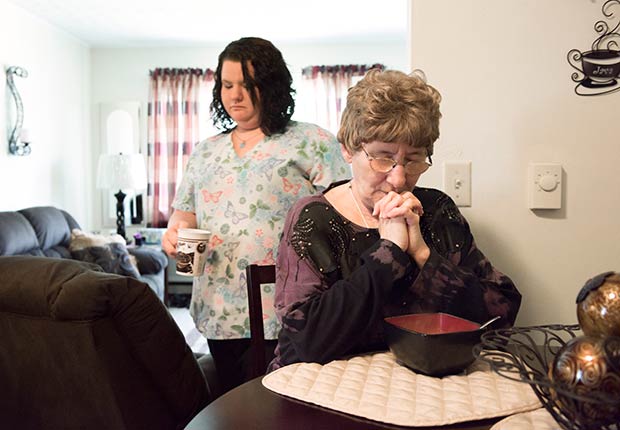AARP Hearing Center

By Jackie Spinner
As her sight gradually deteriorated, Sandra Newbolds had to get down on her hands and knees to clean her apartment in southern Illinois.
But her biggest problem was trying to cook, said Newbolds, 61, who has congenital glaucoma. After she almost caught her shirtsleeve on fire, she turned off the circuit breaker to the stove and started to eat only TV dinners, cooked in the microwave, doing so for almost a year.
“They aren’t very good for you,” she said.
Last year, Newbolds signed up for in-home help through the Williamson County Programs on Aging, which serves the city of Marion, where she lives. She now has an aide cook for her, read her mail and take her to the store.
Newbolds doesn’t pay anything for the seven hours of help she gets each week. The cost is paid by the state’s Community Care Program, which is partially reimbursed by Medicaid, the federal-state health insurance program for low-income people, which is celebrating its 50th anniversary in July.
Roughly 3.2 million people are covered by Medicaid in Illinois, including about 191,600 people over 65.
“I couldn’t afford to pay [for the aide] after rent and electricity and buying the groceries and this and that,” Newbolds said. “This has been a real blessing for me.”
Shift to community care
Increasingly, states are offering home- and community-based services as an alternative to traditional nursing home care.
Nationwide, Medicaid spending on home- and community-based services has more than doubled from 20 percent in 1995 to 45 percent in 2012, according to the Kaiser Family Foundation. Currently, home- and community-based long-term care services represent almost one-half (45 percent) of total Medicaid long-term care expenditures, up from 20 percent in 1995.
Illinois’ program, administered through the Department on Aging, is unique, said Courtney Hedderman, AARP Illinois associate state director for advocacy and outreach. “It’s a very progressive program,” she said.
“It offers a lot of services that other states don’t.”
For example, the Community Care Program provides assistance with household tasks uch as cleaning, planning and preparing meals, doing laundry, shopping and running errands. Aides also help clients with personal care, including dressing, bathing, grooming and following special diets.
“It’s a very holistic approach,” Hedderman said. “When you have that, they are more apt to [remain living] at home. Not every state does that.”
Illinois may not be at the forefront for long, however.
Earlier this year, Gov. Bruce Rauner (R) proposed that Medicaid spending, now nearly $20 billion, be cut by about $1.5 billion in the fiscal year starting July 1. Many of the state’s home care providers expect their client base to be slashed if the cuts are approved and stricter eligibility requirements are adopted.
States set their own Medicaid budgets, which are matched by federal dollars. For every $1 that Illinois spends on traditional Medicaid, the federal government contributes $1.03. For the more than half a million beneficiaries added by the expansion under the Affordable Care Act, the federal government currently pays the full cost, which will decline to 90 percent by 2020.
“Someone once described Illinois’ in-home services as a mile wide and an inch deep,” said Mike O’Donnell, former executive director of the East Central Illinois Area Agency on Aging in Bloomington. “It serves a lot of people with a fairly minimal service package. When you begin to erode an already meager service, it places people at higher risk.”
Carol Aronson, a division director of Shawnee Health Service in Carterville, which serves about 4,000 Community Care clients throughout southern Illinois, said its Senior Alliance already denies about 40 percent of the people who apply because they aren’t impaired enough or have more than $17,500 in assets, the current eligibility limit.
“Our clients are basically homebound,” she said, adding that providing help for them at home costs far less than what Medicaid would pay for long-term institutional care.
The average nursing home stay in Illinois costs Medicaid about $5,800 a month. The average cost of in-home care statewide is about $850 a month.
Bill Lowe, chief executive of Chicagoland Methodist Senior Services, said home care in Illinois is mostly covered by private pay, which makes the Community Care Program particularly important for people who couldn’t otherwise afford it.
“If you are a person of means, you can choose your own destiny,” he said.”You can afford home care.”
Jackie Spinner is a writer living in Chicago.































































